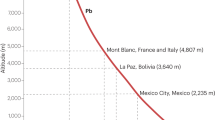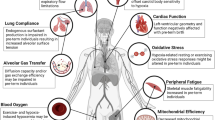Abstract
The human fetus develops normally under low-oxygen conditions. Exposure of a pregnant woman to the hypoxia of high altitude results in acclimatization responses which act to preserve the fetal oxygen supply. The fetus also utilizes several compensatory mechanisms to survive brief periods of hypoxia. While fetal heart rate monitoring data during air travel suggest no compromise of fetal oxygenation, exercise at high altitude may place further stress on oxygen delivery to the fetus. The limited data on maternal exercise at high altitude suggest good tolerance in most pregnancies; however, short-term abnormalities in fetal heart rate and subsequent pregnancy complications have been observed, as well. A survey of Colorado obstetrical care providers yielded consensus that preterm labor and bleeding complications of pregnancy are the most commonly encountered pregnancy complications among high-altitude pregnant visitors. Dehydration, engaging in strenuous exercise before acclimatization, and participation in activities with high risk of trauma are behaviors that may increase the risk of pregnancy complications. Medical and obstetrical conditions which impair oxygen transfer at any step between the environment and fetal tissue may compromise fetal oxygenation. Knowledge of the medical, obstetrical, and behavioral risk factors during pregnancy at high altitude can help the pregnant visitor to high altitude avoid such complications.
Access this chapter
Tax calculation will be finalised at checkout
Purchases are for personal use only
Preview
Unable to display preview. Download preview PDF.
Similar content being viewed by others
References
Artal, R., V. Fortunato, A. Welton et al. A comparison of cardiopulmonary adaptations to exercise in pregnancy at sea level and altitude. Am J Obstet Gynecol 172:1170–1180, 1995.
Baumann, H., P. Bung, F. Fallenstein, et al: Reaktion von Mutter und Fet auf die körperlicher Belastung in der Höhe. Geburtshilfe Frauenheilkd 45:869–876, 1985.
Baumann, H., R. Huch. Höhenexposition und Höhenaufenthalt in der Schwangerschaft: Auswirkungen auf Mutter und Fet. Zentralbl Gynäkol 108:889–899, 1986.
Bung, P. Köperliche Belastung und Sport in der Schwangerschaft-Möglichkeiten und Gefahren unter besonderer Berückischtigung der klinischen Wertigkeit. Habilitationsschrift Med. Fakultät Universität Bonn, 1992.
Carter, A. M. Factors affecting gas transfer across the placenta and the oxygen supply to the fetus. J Devel Physiol 1989; 12:305–322.
Copher, D. E., C. P. Huber. Heart rate response of the human fetus to induced maternal hypoxia. Am J Obstet Gynecol 98:320–335, 1967.
Cotter, J. R., J. N. Blechner, H. Prystowsky. Observations on pregnancy at altitude. I. The respiratory gases in maternal arterial and uterine venous blood. Am J Obstet Gynecol 99:18, 1967.
de Swiet, M. Cardiovascular problems in pregnancy. In Turnbull’s Obstetrics (2nd Ed) Ed. Geoffrey Chamberlain. Edinburgh: Churchill Livingstone, 1995, pp. 369, 370.
Elliott, J. P., R. N. Trujillo. Fetal monitoring during emergency obstetric transport. Am J Obstet Gynecol 157:245–247, 1987.
Fox, H. The placenta, membranes and umbilical cord. In Turnbull’s Obstetrics (2nd Ed) Ed. Geoffrey Chamberlain. Edinburgh: Churchill Livingstone, 1995, pp. 45–60.
Hellegers, A., J. Metcalfe, W. E. Huckabee, et al. Alveolar pCO2 and pO2 in pregnant and nonpregnant women at high altitude. Am J Obstet Gynecol 82:241–245, 1961.
Huch, R. Maternal hyperventilation and the fetus. J Perinat Med 13:1–15, 1985.
Huch, R., H. Baumann, F. Fallenstein, et al. Physiologic changes in pregnant women and their fetuses during jet air travel. Am J Obstet Gynecol 154:996–1000, 1986.
Huch, R. Pregnancy and altitude: physical activity at high altitude, In Artal Mittelmark R., R. A. Wiswell, B. L. Drinkwater (eds): Exercise in Pregnancy. Baltimore, MD, Williams & Wilkins, 1991, pp. 247–260.
Huch, R. Physical activity at altitude in pregnancy. Seminars in Perinatology 20:303–314, 1996.
John, A. H. The effect of maternal hypoxia on the heart rate of the foetus in utero. Brit J Anaesth 37:515–519, 1965.
Koos, B. J., G. G. Power, L. D. Longo. Placental oxygen transfer with considerations for maternal exercise. In Exercise in Pregnancy, Artal R. and R. A. Wiswell (eds). Baltimore: Williams and Wilkins, 1986, pp. 155–180.
Longo, L. L. Respiratory gas exchange in the placenta. Handbook of Physiology. Section3: The Respiratory System, Vol. 4. Bethesda, MD: American Physiological Society, 1987, pp. 351–401.
Makowski, E. L., F. C. Battaglia, G. Meschia, R. E. Behrman, J. Schruefer, et al. Effect of maternal exposure to high altitude upon fetal oxygenation. Am J Obstet Gynecol 100: 852–861, 1968.
Meschia, G. Supply of oxygen to the fetus. J Reprod Med 23:160–165, 1979.
Moore, L. G. Altitude, effects on humans. Encyclopedia of Reproduction 1:107–112, 1999.
Morton, M. J., M. S. Paul, G. R. Campos, M. V. Hart, J. Metcalfe. Exercise dynamics in late gestation: effects of physical training. Am J Obstet Gynecol 152:91–97, 1985.
Parer, J. Effects of hypoxia on the mother and fetus with emphasis on maternal air transport. Am J Obstet Gynecol 142:957–961, 1982.
Parer, J. T. The effect of acute maternal hypoxia on fetal oxygenation and the umbilical circulation in the sheep. Europ J Obstet Gynecol Reprod Biol 10:125–136, 1980.
Parer, J. T., H. R. Dijkstra, P. P. M. Vredebregt, J. L. Harris, T. R. Krueger, M. L. Reuss. Increased fetal heart rate variability with acute hypoxia in chronically instrumented sheep. Europ J Obstet Gynecol Reprod Biol 10:393–399, 1980.
Ramsey, E. M. Circulation of the placenta. Birth Defects, Original Articles Series 1:5–12, 1965.
Sobrevilla, L. A., M. T. Cassinelli, A. Carcelen, J. M. Malaga. Human fetal and maternal oxygen tension and acid-base status during delivery at high altitude. Am J Obstet Gynecol 111:1111–1118, 1971.
Sorenson, S., J. Severinghaus. Respiratory sensitivity to acute hypoxia in man born at sea level living at high altitude. J Appl Physiol 25:211–216, 1968.
Wood, C., J. Hammond, J. Lumley, W. Newman. Effect of maternal inhalation of 10% oxygen upon the human fetus. Aust NZ J Obstet Gynecol 11:85–90, 1971.
Author information
Authors and Affiliations
Editor information
Editors and Affiliations
Rights and permissions
Copyright information
© 1999 Springer Science+Business Media New York
About this chapter
Cite this chapter
Niermeyer, S. (1999). The Pregnant Altitude Visitor. In: Roach, R.C., Wagner, P.D., Hackett, P.H. (eds) Hypoxia. Advances in Experimental Medicine and Biology, vol 474. Springer, Boston, MA. https://doi.org/10.1007/978-1-4615-4711-2_5
Download citation
DOI: https://doi.org/10.1007/978-1-4615-4711-2_5
Publisher Name: Springer, Boston, MA
Print ISBN: 978-1-4613-7134-2
Online ISBN: 978-1-4615-4711-2
eBook Packages: Springer Book Archive




